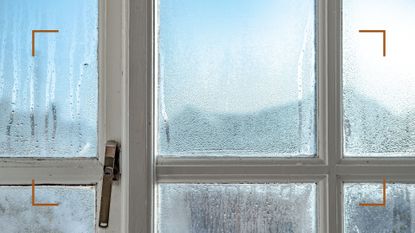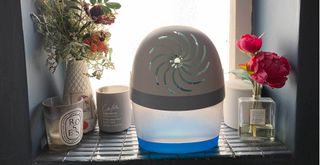How to prevent condensation on windows, according to experts: 8 easy solutions
Preventing and removing condensation on windows can seem like a tedious task, but these expert tips are simple to follow and prevent it from causing further damage


Do you wake up most mornings in colder months wondering why your window panes are misted with vapour and tiny dripping droplets? Knowing how to prevent condensation on windows is essential for preventing dangerous mould and long-term surface damage.
During winter months, windows chill on the outside and ventilation becomes limited inside your home as we add heating to the mix as we strive to keep our houses warm in winter, this clash of conditions leads to water build-up on glazed surfaces and is known as window condensation.
If neglected dampness can lead to expensive window and frame damage, and can spread to walls causing health-hazardous black mould patches.
"Continuous, sitting condensation can lead to mould, long exposure to which can be detrimental to our health and can damage windows, causing more issues down the line, " explains Victoria Brocklesby, COO at Origin.
We ask experts in the world of windows and home improvement for the best methods to prevent condensation on windows with ease.
How to prevent condensation on windows
Condensation is a nuisance more common in colder months, but if you know how to prevent condensation on windows it is possible to stop those tiny droplets from becoming a bigger problem down the line.
"Every type of window is prone to condensation, but it is possible to prevent it from forming," says Rachael Munby from Anglian Home Improvements.
Sign up for the woman&home newsletter
Sign up to our free daily email for the latest royal and entertainment news, interesting opinion, expert advice on styling and beauty trends, and no-nonsense guides to the health and wellness questions you want answered.
Here are a few simple tips that might help you reduce condensation on the inside of your windows:
1. Increase and improve ventilation

We may be looking for ways to save money on heating bills this winter but at some point, the central heating will have to be switched on.
With windows kept shut ventilation problems can occur resulting in condensation, mould, and dampness. Autumn and early winter are the ideal times to spot and resolve these issues.
If windows are fitted with trickle vents, which are small components within a window or a door, ensure they are open. "Briefly opening trickle vents or opening the window slightly after a shower or cooking can help dispel a build-up of condensation," adds Victoria. Failing that crack open the window every morning for short periods to release trapped humid air.
Additionally, a good extractor fan near your shower (if you don’t already have one installed) is a wise buy.
Property expert, Thomas Goodman from MyJobQuote advises: "Adding extractor fans in the kitchen and bathroom will also help to prevent excess moisture from causing problems. If you already have extractor fans, now’s a great time to give them a clean and renew the filters."
2. Moderate the heating

Shifting temperatures in the home can actually increase condensation. So, although some argue constantly heating your home wastes energy if your home is prone to damp conditions, it may be more practical in the long run to leave an element of heating on a low level to prevent large temperature fluctuations.
"Rather than allowing your heating to swing between hot and cold, keep your heating on a constant low temperature," suggests Louis McGee, glazing expert at Cloudy2Clear "This will help to prevent dampness from forming in your home."
"Also, try keeping doors closed in rooms you are using and attempt to keep the thermostat at the same temperature in every room," adds Sarah Smith, head of home underwriting at LV= General Insurance "This can help prevent condensation in your house too."
3. Open curtains and blinds

Opening curtains and blinds as soon as possible in the morning can help to keep fabrics away from any potentially damp surfaces. This will also encourage air circulation and allows natural sunlight to evaporate moist particles in the air.
“Condensation is not aesthetically pleasing and can damage your window dressings so it is best to tackle it immediately to prevent any issues from developing," advises Yvonne Keal, senior product manager at Hillarys.
"Temperature fluctuations can be responsible for condensation forming on windows. If your window suffers from condensation, this could result in mould forming on your curtain lining or blind. "
4. Clear existing moisture
An immediate and short-term solution to condensation is to remove any water droplets you come across in your home as soon as they appear.
Invest in a window vac to suck up the liquid immediately. We recommend the best-selling Kärcher WV 1 Window Vac, £39 at Amazon. Or, use an old towel (or paper towels) and a glazing squeegee that won’t damage your windows.
"Before the moisture gets soaked into the walls, wipe off the condensation with paper towels and dab it across the window sill," advises John Cutts, glass expert at MeandMyGlass.co.uk. "It’s also worth wiping across blinds to stop mould from forming.
First, place the towel or paper at the bottom of the window to collect the liquid as it reaches the bottom. Then, starting from the top of the pane, use the squeegee to remove moisture without causing streaks. Work along in downward strokes until the window is clear. Finish by ensuring the panes of glass are dry by wiping them with a clean microfiber cloth.
5. Invest in a dehumidifier

If your home is prone to condensation one of the best dehumidifiers will make a wise investment because it is probably the most effective method when looking for ways to prevent condensation on windows.
How do dehumidifiers work? They draw moisture from the air and deposit the liquid into a container which is manually poured away.
According to Wethrift, dehumidifiers are the best way to reduce the level of humidity in your home and over the last few months, they found demand for the product has increased by a huge 455%. “Dehumidifiers can also help to reduce the cost of heating bills, as the moisture in the air is what makes a room feel cold,” adds trend expert Nick Drewe from Wethrift.
Not only are dehumidifiers good for drying clothes they also improve air quality as mould particles and microbes are also collected within the fluid and disposed of.
On a budget? Look out for affordable Black Friday dehumidifier deals or try a compact dehumidifier which is smaller and much less expensive. Obviously, as they are more petite they hold much less water (usually about 300ml) and so have to be emptied more often. Best for small rooms, they are more discreet than their bigger, more expensive counterparts.
6. Try moisture absorbers

Moisture absorbers are gadgets that require no electricity. Costing approximately the same as a box of laundry detergent, they are capable of extracting water vapour from the air by drawing moisture into containers filled with mineral salt known otherwise as calcium chloride. These are really only suitable for smaller spaces to tackle condensation, such as bathrooms.
This model shown (in our Lifestyle Editor's home ) is the UniBond Aero 360 Pure Moisture Absorber Dehumidifier, £12.99 at Robert Dyas which is refillable. We can also recommend the Lakeland Mini Moisture & Condensation Trap, just £3.99 that lasts for three months.
7. Dry clothes more effectively indoors

Conquering the laundry pile quicker can help because drying clothes indoors when it's cold outside, makes the air super soggy, and this can lead to window condensation overload. Therefore knowing how to dry clothes indoors during winter efficiently is crucial to minimizing humid conditions.
Hang clothes from hangers on drying rails and load clothes dryers efficiently to welcome faster drying times to minimize the amount of moisture released into the air.
Never dry clothes on a radiator located under a window, as the heat from the radiator instantly throws the moisture from drying garments up onto the glass panes above.
If using a tumble dryer ensure it has an effective vent that dispels moisture outside, otherwise you are effectively adding to the problem.
8. Reduce moisture levels with plants

It's incredible to think that some of the best plants (you can buy online) can actually help improve our homes. Whether it's using herbs as a natural remedy to get rid of flies or the best flowers to make a house look expensive, welcoming nature into our homes can be invaluable.
To help combat moisture levels and prevent condensation on windows John advises: "It’s always worth getting houseplants like spider plants and orchids which are known to help reduce moisture in the air to make condensation more manageable. For the best results, have them placed on the windowsill."
FAQ
What causes condensation on windows?
When winter sets in and the heating is switched on, knowing how to prevent condensation on windows becomes far more important than knowing how to clean windows without streaks because the issue if left for too long, can cause far bigger problems that might end up being expensive to fix further down the line.
During the summer months daily routines such as showers, boiling kettles, laundry, and even people breathing lead to an amount of humidity and condensation build-up that is usually released through open windows. But, during winter central heating systems are switched on, we close windows and colder air chills window panes on the outside.
As humid air on the inside can no longer escape it turns to moisture as soon as it hits the cold window pane. Build-up then leads to droplets which very quickly become pools of unwelcomed water.
“Condensation on windows is caused by the cold glass colliding with warm air from the inside, making it unavoidable to a certain extent, particularly in the winter months" explains Victoria.

Why is window condensation concerning?
Knowing how to prevent condensation on windows is important because not only is the moisture annoying and unsightly, but constant wetness can not only ruin the window frames themselves but it can also cause serious health problems.
Excess moisture from window condensation is a leading offender in developing mould and mildew in the home. Mold is a serious health risk. NHS UK states:
"Molds produce allergens (substances that can cause an allergic reaction), irritants, and, sometimes, toxic substances. Inhaling or touching mould spores may cause an allergic reaction, such as sneezing, a runny nose, red eyes, and skin rash. Molds can also cause asthma attacks."
If you suspect you have mould in your home follow our mold removal guide.
What temperature should my house be to prevent condensation on windows?
As condensation is formed when temperatures outside are considerably lower than inside, it's sensible to keep thermostats at an even low setting and avoid temperature fluctuation.
Tony Adams, boiler and heating expert, and spokesperson for Village Heating, told the Express newspaper, that he recommended keeping the heating between 15C and 17C, rather than turning it on much higher.
Tony explained, “This allows your home to reach a constant temperature, which stops water forming on windows".
Does putting the heating on stop condensation on windows?
In short, yes. Having the heating on can help prevent condensation on the windows because the temperature fluctuates less. If you are not in a position to have the heating on all the time, John advises when it's most important to tackle condensation on windows, saying: "Putting the heating on for around 20 minutes in the morning can help control the humidity in the room." This is because the temperatures drop at night so the air indoors is colder first thing in the morning.
John also advises, "Open the windows first to get a healthy airflow going, then put the heating on to stop the windows from steaming up. Having the windows open will allow more ventilation in the room and will reduce indoor humidity levels. It also works on helping to prevent mould growth as it reduces the amount of moisture in the air."
Rachel Homer has been in the interiors publishing industry for over 15 years. Starting as a Style Assistant on Inspirations Magazine, she has since worked for some of the UK’s leading interiors magazines and websites. After starting a family, she moved from being a content editor at Ideal Home to be a digital freelancer and hasn’t looked back.